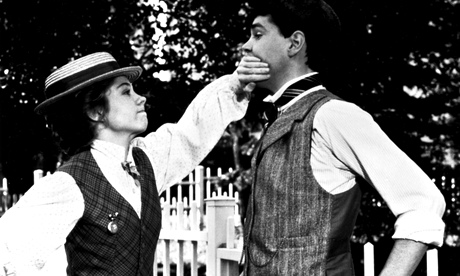
It’s been a sad week for literary ladies of a certain generation: Gilbert Blythe has died. OK, not the actual (by which I mean fictional) Gilbert – he is still romping through the pages of Lucy Maud Montgomery’s classic 1908 novel, Anne of Green Gables, teasing and adoring the red-haired orphan, Anne Shirley. But the image so many women of my generation have of Gilbert is no more: the actor Jonathan Crombie, who played him in the timeless 1985 Canadian TV adaptation of the novels, died of a brain haemorrhage last week at the heartbreakingly young age of 48. Crombie was Colin Firth-as-Mr Darcy for 14-year-old girls, and we former 14-year-olds have not been coping well.
Since the announcement of Crombie’s death, the internet has become awash with Crombie-as-Blythe web art and souvenirs that betray more ardour than, shall we say, rational thinking. “Crombie gave Gilbert caring, intelligence and dreaminess: qualities that enchant seventh-grade girls,” Sarah Larson wrote in the New Yorker
It’s true, Crombie did give flesh and meaningful stares (adolescent girls love a good meaningful stare) to a fictional character. But the feelings his death sparked have at least as much to do with the character of Gilbert as with Crombie himself.
Gilbert is an unusual male character in a novel ostensibly aimed at women, in that he is not utterly ridiculous at best and completely hateful at worst. I read Anne of Green Gables around the same time I started reading the works of Jane Austen, the Brontës, Louisa May Alcott, Daphne du Maurier, Margaret Mitchell, George Eliot and all the classic novels adolescent girls who love reading eventually come to read.
Gilbert alone was the hero I could imagine myself spending an afternoon with, and was in retrospect the only one who provided a positive template for future nonfictional men in my life.
Gilbert first appears in Anne of Green Gables at school, “a tall boy, with curly brown hair, roguish hazel eyes and a mouth twisted into a teasing smile”. But he also turns out to be one of the great feminist heroes: he and Anne are the best students in their year, and he openly admires her brilliance and mouthiness, saying brains are more important than looks even while she arrogantly disdains him for years. After they graduate from school, he secretly gives up his job so she can take it instead. Even after Anne rejects him many times, and later his marriage proposal, he still looks out for her. Anne finally realises she loves Gilbert in the third book in the series, Anne of the Island, and tells him: “I don’t want sunbursts and marble halls – I just want you.” Gilbert, for his part, tells her he loved her since the first day he saw her and called her Carrots, “and you broke your slate over my head”.
Now, let us compare Gilbert to some of the men in other books aimed at a roughly similar demographic. All of them can be divided into four categories: sexy monsters (Heathcliff, Mr Rochester, Maxim de Winter, Mr Darcy, Rhett Butler), wet toffs (Mr Bingley, Edward Ferrars, Laurie in Little Women), flouncy romantics (Will Ladislaw, Daniel Deronda) and unsexy father figures (Colonel Brandon, Mr Knightley, Professor Bhaer).
While young Gilbert unhappily but stoically accepts Anne’s rejection of him, Laurie in Little Women is so horrified when Jo turns him down he flounces off and marries her silly little sister, and the middle-aged Captain Wentworth sails off in a huff in Persuasion after Anne Elliot knocks him back; he then flirts with an airhead, and nearly causes her death.
It is often noted how little attention is given to female characters in pop culture aimed at men (which is to say, most pop culture). But the same can be said in reverse, including of literature that is largely read by girls and women. Austen never seemed very interested in her male characters beyond what financial security they could provide for her heroines, while the Brontës were incapable of writing male characters who were much more than overheated adolescent fantasies.
The sexy monster tamed by the love of a good woman remains the most enduring archetype, as anyone who has read Twilight (or Fifty Shades of Grey) knows well. The authors lavish attention on the female protagonists in the above novels, which is why they are so loved. But in comparison the men often feel like two-dimensional afterthoughts, and never once have I put down any of the above novels and thought: “Yes, that chap is definitely worthy of the sparky heroine, and he will support all her intellectual ambitions.”
Except for Gilbert Blythe, that is. Montgomery was clearly as interested in her hero as she was in her heroine, and as a result created a male character women can, and should, love. Crombie is sadly dead, but the lessons of Gilbert will live on.

